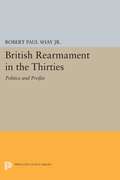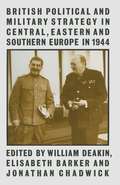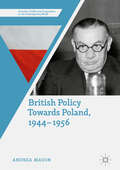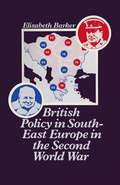- Table View
- List View
British Sniping Rifles since 1970: L42A1, L96A1 and L115A3 (Weapon)
by Steve HoughtonIn response to the challenge of the Soviet Dragunov self-loading rifle, the British Army adopted the 7.62mm L42A1 bolt-action sniping rifle in 1970. The L42A1 was deployed in Dhofar and Northern Ireland, but arguably saw its finest hour during the Falklands War in 1982. The harsh conditions of the South Atlantic laid bare the L42A1's inadequacies and a new company, Accuracy International, won the contract to replace the L42A1 and the PM Rifle, a world-beating revolutionary design, was adopted in 1985 as the L96A1. Progressively upgraded, the L96A1 went on to serve as the British Army's primary sniper system, being deployed in Northern Ireland, the First Gulf War, Bosnia, Iraq and Afghanistan. The L115A3, chambered in .338 Lapua Magnum, joined the L96A1 in the front line in 2008 and since 2012 has been Britain's standard issue sniping rifle. Featuring full-colour artwork and close-up photographs, this absorbing study assesses the development, combat use, impact and legacy of these three iconic British sniping weapons.
British Sniping Rifles since 1970: L42A1, L96A1 and L115A3 (Weapon)
by Steve HoughtonIn response to the challenge of the Soviet Dragunov self-loading rifle, the British Army adopted the 7.62mm L42A1 bolt-action sniping rifle in 1970. The L42A1 was deployed in Dhofar and Northern Ireland, but arguably saw its finest hour during the Falklands War in 1982. The harsh conditions of the South Atlantic laid bare the L42A1's inadequacies and a new company, Accuracy International, won the contract to replace the L42A1 and the PM Rifle, a world-beating revolutionary design, was adopted in 1985 as the L96A1. Progressively upgraded, the L96A1 went on to serve as the British Army's primary sniper system, being deployed in Northern Ireland, the First Gulf War, Bosnia, Iraq and Afghanistan. The L115A3, chambered in .338 Lapua Magnum, joined the L96A1 in the front line in 2008 and since 2012 has been Britain's standard issue sniping rifle. Featuring full-colour artwork and close-up photographs, this absorbing study assesses the development, combat use, impact and legacy of these three iconic British sniping weapons.
The British Sailor of the Second World War (Shire Library #739)
by Angus KonstamThis book tells the dramatic story of how the Royal Navy transformed ordinary citizens into first-rate sailors and navy personnel during the Second World War. It covers how they were recruited and trained and how they endured life at sea in hostile waters, protecting convoys in the Mediterranean, hunting submarines in the Atlantic, and standing up to relentless air attacks in the Pacific. Told through vivid first-hand accounts of life onboard, it reveals what it was like to be a sailor navigating, patrolling, and fighting in the largest theatre of the war – the vast oceans.
The British Sailor of the Second World War (Shire Library)
by Angus KonstamThis book tells the dramatic story of how the Royal Navy transformed ordinary citizens into first-rate sailors and navy personnel during the Second World War. It covers how they were recruited and trained and how they endured life at sea in hostile waters, protecting convoys in the Mediterranean, hunting submarines in the Atlantic, and standing up to relentless air attacks in the Pacific. Told through vivid first-hand accounts of life onboard, it reveals what it was like to be a sailor navigating, patrolling, and fighting in the largest theatre of the war – the vast oceans.
The British Sailor of the First World War (Shire Library)
by Quintin ColvilleIn 1914 Great Britain had the largest and most powerful navy the world had ever seen – a well-known fact, but what of the everyday experience of those who served in her? This fully illustrated book looks at the British sailor's life during the First World War, from the Falkland Islands to the East African coast to the North Sea. Meals in the stokers' mess and the admiral's cabin; the claustrophobic terrors of the engine room or submarine; the long separations from loved ones that were the shared experience of all ranks; the perils faced by Royal Naval Air Service pilots in the air; the possessions treasured by sailors while at sea – drawing on a wealth of previously unpublished materials from the National Maritime Museum archives, this is an authoritative and vivid account of lives lived in quite extraordinary circumstances.
The British Sailor of the First World War (Shire Library)
by Quintin ColvilleIn 1914 Great Britain had the largest and most powerful navy the world had ever seen – a well-known fact, but what of the everyday experience of those who served in her? This fully illustrated book looks at the British sailor's life during the First World War, from the Falkland Islands to the East African coast to the North Sea. Meals in the stokers' mess and the admiral's cabin; the claustrophobic terrors of the engine room or submarine; the long separations from loved ones that were the shared experience of all ranks; the perils faced by Royal Naval Air Service pilots in the air; the possessions treasured by sailors while at sea – drawing on a wealth of previously unpublished materials from the National Maritime Museum archives, this is an authoritative and vivid account of lives lived in quite extraordinary circumstances.
British Rifleman vs French Skirmisher: Peninsular War and Waterloo 1808–15 (Combat #46)
by David GreentreeThe battles between British and French forces during the Peninsular War (1807–14) and the Hundred Days campaign of 1815 saw both sides deploy specialist units of skirmishers trained in marksmanship and open-order combat. These 'light' troops fulfilled several important roles on the battlefield, such as 'masking' large bodies of close-order troops as they manoeuvred in battle, firing upon enemy troops to provoke them into attacking prematurely, and harassing enemy artillery crews and senior officers with aimed fire. On occasion, the skirmishers were tasked with special missions requiring individual initiative, such as the capture or defence of key battlefield positions, especially those situated in difficult terrain. While Napoleon's skirmishers carried the smoothbore musket, notoriously inaccurate and short-ranged, several elite units fighting for Britain were armed with the rifle, a far more accurate weapon that was hampered by a slower rate of fire. As well as the legendary 95th Rifles, Britain fielded rifle-armed German troops of the 60th Regiment and the King's German Legion, while France's light troops were fielded in individual companies but also entire regiments. In this study, David Greentree assesses the role and effectiveness of rifle-armed British troops and their French open-order opponents in three very different encounters: Roliça (August 1808), the first British battle of the Peninsular War; the struggle for a key bridge at Barba del Puerco (March 1810); and the bitter fight for the La Haye Sainte farmhouse during the battle of Waterloo (June 1815).
British Rifleman vs French Skirmisher: Peninsular War and Waterloo 1808–15 (Combat)
by David GreentreeThe battles between British and French forces during the Peninsular War (1807–14) and the Hundred Days campaign of 1815 saw both sides deploy specialist units of skirmishers trained in marksmanship and open-order combat. These 'light' troops fulfilled several important roles on the battlefield, such as 'masking' large bodies of close-order troops as they manoeuvred in battle, firing upon enemy troops to provoke them into attacking prematurely, and harassing enemy artillery crews and senior officers with aimed fire. On occasion, the skirmishers were tasked with special missions requiring individual initiative, such as the capture or defence of key battlefield positions, especially those situated in difficult terrain. While Napoleon's skirmishers carried the smoothbore musket, notoriously inaccurate and short-ranged, several elite units fighting for Britain were armed with the rifle, a far more accurate weapon that was hampered by a slower rate of fire. As well as the legendary 95th Rifles, Britain fielded rifle-armed German troops of the 60th Regiment and the King's German Legion, while France's light troops were fielded in individual companies but also entire regiments. In this study, David Greentree assesses the role and effectiveness of rifle-armed British troops and their French open-order opponents in three very different encounters: Roliça (August 1808), the first British battle of the Peninsular War; the struggle for a key bridge at Barba del Puerco (March 1810); and the bitter fight for the La Haye Sainte farmhouse during the battle of Waterloo (June 1815).
A British Rifleman - the Journals and Correspondence of Major George Simmons, Rifle Brigade, during the Peninsular war and the campaign of Waterloo
by Lt.-Colonel Willoughby Cole Verner Major SimmonsThe journals and correspondence of George Simmons add a further lustre to the excellent memoirs and books that men of the 95th Rifles left of the adventures, hard fought actions and grim experiences of the Peninsular War and the Waterloo Campaign. Simmons was commissioned into the 1st Battalion 95th Rifles, a fellow officer of Sir John Kincaid and Sir Harry Smith both of whom left valuable memoirs of the period. A religious and upright man, although not priggish, he kept a journal of the actions movement and events of his life and sent numerous letters home to his family in Hull. These form the narrative which has been ordered by Lt. Col. Verner to flow in sequence through his time fighting Napoleon’s forces.Simmons, and his brothers who often crop up in the volume, was at the forefront of the fighting engaged in by the Light Brigade and later Light Division. He was wounded a number of times, once so seriously at Waterloo as a result of a musket wound to the chest, that his attendants though he might die. He took part in the battles of Fuentes D’Oñoro, Salamanca, Vittoria, the Nivelle, Orthez and finally Waterloo. The storming of Badajoz, Cuidad Rodrigo are also described in vivid detail missing nothing of the fear, death and mayhem of the attacking troops; to give just one excerpt of the action:- I saw my poor friend Major O'Hare lying dead upon the breach. Two or three musket balls had passed through his breast. A gallant fellow, Sergeant Flemming, was also dead by his side, a man who had always been with him. I called to remembrance poor O'Hare's last words just before he marched off to lead the advance. He shook me by the hand saying, "A Lieutenant-Colonel or cold meat in a few hours." I was now gazing upon his body lying stretched and naked amongst thousands more.An excellent read, contemporaneously written and abounding with interesting details.Author – Major George Simmons [1785-1858]Editor – Lt.-Col Willoughby Cole Verner [1852-1922]
British representations of the Spanish Civil War
by Brian ShelmerdineThis book looks at the reception of the Spanish Civil War in British popular culture, and how supporters of both sides in Britain used the rhetoric and imagery of the conflict to bolster support for their respective causes in the arena of British public opinion. Brian Shelmerdine finds that traditional notions of Spain as a country of bullfighting, bandits and flamenco were pervasive and were significant in shaping wider UK government policy towards Spain. He carefully assesses the different political perceptions of the 1930s Spanish scene, the role of the Catholic Church, the depiction of the two sides in terms of class, race and ethnicity, humanitarian appeals, and the plight of the Basques. The book is fluently written, and should make fascinating and entertaining reading for scholars of British society and culture in the twentieth century, as well as those investigating international impact of the Spanish Civil War.
British Redcoat vs French Fusilier: North America 1755–63 (Combat)
by Peter Dennis Stuart ReidProviding a unique glimpse into the experiences of regular British and French infantry during the French and Indian War, Stuart Reid reveals what it was like to fight in three battles at the height of the struggle for Canada: La Belle-Famille, the Plains of Abraham and Sainte-Foy. In 1755, Britain and France both decided to escalate a low intensity frontier war that had started the previous year by dispatching regular troops to their respective colonies in North America. Far from home, both sides' equipment and tactics were initially more suited to the European theatre. As the war ground on, however, combat doctrine evolved as both armies learned lessons that would be utilized by succeeding generations of soldiers. Packed with first-hand accounts, dramatic illustrations and a technical analysis of the changing nature of warfare on the American continent, this book puts readers in the shoes of the combatants who played a pivotal role in shaping the future of North America.
British Redcoat vs French Fusilier: North America 1755–63 (Combat)
by Peter Dennis Stuart ReidProviding a unique glimpse into the experiences of regular British and French infantry during the French and Indian War, Stuart Reid reveals what it was like to fight in three battles at the height of the struggle for Canada: La Belle-Famille, the Plains of Abraham and Sainte-Foy. In 1755, Britain and France both decided to escalate a low intensity frontier war that had started the previous year by dispatching regular troops to their respective colonies in North America. Far from home, both sides' equipment and tactics were initially more suited to the European theatre. As the war ground on, however, combat doctrine evolved as both armies learned lessons that would be utilized by succeeding generations of soldiers. Packed with first-hand accounts, dramatic illustrations and a technical analysis of the changing nature of warfare on the American continent, this book puts readers in the shoes of the combatants who played a pivotal role in shaping the future of North America.
British Redcoat 1740–93 (Warrior)
by Richard Hook Stuart ReidDuring this period, the British army earned itself a formidable reputation as a fighting force. However, due to its role as a police force at home, and demonisation by American propaganda, the army was viewed as little removed from a penal institution run by aristocratic dilettantes. This view, still held by many today, is challenged by Stuart Reid, who paints a picture of an increasingly professional force. This was an important time of change and improvement for the British Army, and British Redcoat 1740-1793 fully brings this out in its comprehensive examination of the lives, conditions and experiences of the late 18th-century infantryman.
British Redcoat 1740–93 (Warrior #No. 19)
by Richard Hook Stuart ReidDuring this period, the British army earned itself a formidable reputation as a fighting force. However, due to its role as a police force at home, and demonisation by American propaganda, the army was viewed as little removed from a penal institution run by aristocratic dilettantes. This view, still held by many today, is challenged by Stuart Reid, who paints a picture of an increasingly professional force. This was an important time of change and improvement for the British Army, and British Redcoat 1740-1793 fully brings this out in its comprehensive examination of the lives, conditions and experiences of the late 18th-century infantryman.
British Rearmament in the Thirties: Politics and Profits (PDF)
by Robert Paul Shay Jr.Here is a comprehensive analysis of rearmament under the Baldwin and Chamberlain governments. It reveals the primary determinants of events and provides important new information regarding the principal considerations underlying Chamberlain's policy of appeasement. The author concentrates on a problem that was of central concern to the government. For this reason, and because he draws on the recently opened Cabinet and Treasury papers at the Public Record Office in London, he is able to offer a broader view than that of the existing studies. He describes in detail the interaction of the Cabinet, Treasury, and Armed Services, and the influence of the financial and industrial communities.Originally published in 1977.The Princeton Legacy Library uses the latest print-on-demand technology to again make available previously out-of-print books from the distinguished backlist of Princeton University Press. These editions preserve the original texts of these important books while presenting them in durable paperback and hardcover editions. The goal of the Princeton Legacy Library is to vastly increase access to the rich scholarly heritage found in the thousands of books published by Princeton University Press since its founding in 1905.
The British Press and the Greek Crisis, 1943–1949: Orchestrating the Cold-War ‘Consensus’ in Britain (Palgrave Studies in the History of the Media)
by Gioula KoutsopanagouThis book provides the first detailed analysis of how interactions between government policy and Fleet Street affected the political coverage of the Greek civil war, one of the first major confrontations of the Cold War. During this period the exponential growth of media influence was an immensely potent weapon of psychological warfare. Throughout the 1940s the press maintained its position as the most powerful medium and its influence remained unchallenged. The documentary record shows that a British media consensus was more fabricated than spontaneous, and the tools of media persuasion and manipulation were extremely important in building acceptance for British foreign policy. Gioula Koutsopanagou examines how this media consensus was influenced and molded by the British government and how Foreign Office channels were key to molding public attitudes to British foreign policy. These channels included system of briefings given by the News Department to the diplomatic correspondents, and the contacts between embassies and the British foreign correspondents.
British PoWs and the Holocaust: Witnessing the Nazi Atrocities
by Russell WallisIn the network of Nazi camps across wartime Europe, prisoner of war institutions were often located next to the slave camps for Jews and Slavs; so that British PoWs across occupied Europe, over 200,000 men, were witnesses to the holocaust. The majority of those incarcerated were aware of the camps, but their testimony has never been fully published. Here, using eye-witness accounts held by the Imperial War Museum, Russell Wallis rewrites the history of British prisoners and the Holocaust during the Second World War. He uncovers the histories of men such as Cyril Rofe, an Anglo-Jewish PoW who escaped from a work camp in Upper Silesia and fled eastwards towards the Russian lines, recounting his shattering experiences of the so-called 'bloodlands' of eastern Poland. Wallis also shows how and why the knowledge of those in the armed forces was never fully publicised, and how some PoW accounts were later exaggerated or fictionalised. British PoWs and the Holocaust will be an essential new oral history of the holocaust and an extraordinary insight into what was known and when about the greatest crime of the 20th century.
British PoWs and the Holocaust: Witnessing the Nazi Atrocities (International Library of Twentieth Century History)
by Russell WallisIn the network of Nazi camps across wartime Europe, prisoner of war institutions were often located next to the slave camps for Jews and Slavs; so that British PoWs across occupied Europe, over 200,000 men, were witnesses to the holocaust. The majority of those incarcerated were aware of the camps, but their testimony has never been fully published. Here, using eye-witness accounts held by the Imperial War Museum, Russell Wallis rewrites the history of British prisoners and the Holocaust during the Second World War. He uncovers the histories of men such as Cyril Rofe, an Anglo-Jewish PoW who escaped from a work camp in Upper Silesia and fled eastwards towards the Russian lines, recounting his shattering experiences of the so-called 'bloodlands' of eastern Poland. Wallis also shows how and why the knowledge of those in the armed forces was never fully publicised, and how some PoW accounts were later exaggerated or fictionalised. British PoWs and the Holocaust will be an essential new oral history of the holocaust and an extraordinary insight into what was known and when about the greatest crime of the 20th century.
British Postcards of the First World War (Shire Library #582)
by Peter DoylePostcards sent by men on the front, and to them by their families, are among the most numerous, and most telling, surviving artefacts of the Great War. They tell us much about attitudes towards the war, and provide a great insight into men's lives, and into the thoughts and emotions of those left behind. Very different in their illustration, and in their writing, between the beginning of the war and the end, postcards provide a social history of the war in microcosm. Illustrated with a wide range of postcards, this is a fascinating look into the response of the British people to the horrors of the war.
British Postcards of the First World War (Shire Library)
by Peter DoylePostcards sent by men on the front, and to them by their families, are among the most numerous, and most telling, surviving artefacts of the Great War. They tell us much about attitudes towards the war, and provide a great insight into men's lives, and into the thoughts and emotions of those left behind. Very different in their illustration, and in their writing, between the beginning of the war and the end, postcards provide a social history of the war in microcosm. Illustrated with a wide range of postcards, this is a fascinating look into the response of the British people to the horrors of the war.
British Political and Military Strategy in Central, Eastern and Southern Europe in 1944
by Elisabeth Barker William Deakin Leighton Evans Jonathan ChadwickBritish Policy Towards Poland, 1944–1956 (Security, Conflict and Cooperation in the Contemporary World)
by Andrea MasonThis book examines the outcome of the British commitment to reconstitute a sovereign Polish state and establish a democratic Polish government after the Second World War. It analyses the wartime origins of Churchill’s commitment to Poland, and assesses the reasons for the collapse of British efforts to support the leader of the Polish opposition, Stanisław Mikołajczyk, in countering the attempt by the Polish communist party to establish one-party rule after the war. This examination of Anglo-Polish relations is set within the broader context of emerging early Cold War tensions. It addresses the shift in British foreign policy after 1945 towards the US, the Soviet Union and Europe, as British leaders and policymakers adjusted both to the new post-war international circumstances, and to the domestic constraints which increasingly limited British policy options. This work analyses the reasons for Ernest Bevin’s decision to disengage from Poland, helping to advance the debate on the larger question of Bevin’s vision of Britain’s place within the newly reconfigured international system. The final chapter surveys British policy towards Poland from the period of Sovietisation in the late 1940s up to the October 1956 revolution, arguing that Poland’s process of liberalisation in the mid-1950s served as the catalyst for limited British reengagement in Eastern Europe.
British Policy in South East Europe in the Second World War (Studies in Russian and East European History and Society)
by Elisabeth BarkerBritish Policy and Strategy towards Norway, 1941-45 (Studies in Military and Strategic History)
by C. MannAfter the German occupation of 1940, Britain was forced to reassess its relationship with Norway, a country largely on the periphery of the main theatres of the Second World War. Christopher Mann examines British military policy towards Norway, concentrating on the commando raids, deception planning and naval operations.
British Paratrooper vs Fallschirmjäger: Mediterranean 1942–43 (Combat)
by Johnny Shumate David GreentreeThe airborne forces of Britain and Germany were among their best troops of World War II and when they met in battle the result was a brutal trial of strength. British paratroopers and German Fallschirmjäger clashed repeatedly and their training, tactics, experience, morale and weaponry were tested against each other, not least in the three bruising encounters outlined here, in Tunisia and Sicily. From the British attempts to seize the airfields at Depienne and Oudna to the bloody night battle for Green Hill and the bitter struggle for Primosole Bridge in Sicily, these highly trained parachute troops clashed with their opposite numbers, gaining experience, refining tactics and learning valuable lessons.





















